THE KING EDWARD VII MEMORIAL GATE
Opened on 26th Nov 2018 (You can download a copy of the Harrogate Advertiser article of 29th Nov regarding the Opening Ceremony by clicking here.)
Project led by David Mason. This project is now complete.
Many years ago, one of the pillars at this entrance was lost because of an accident. This project identified a suitable entrance design and has replaced the old entrance.
The construction part of the King Edward VII Memorial Gate project undertaken by Friends of Valley Gardens in partnership with Harrogate Borough Council is now complete and visitors are rewarded with the spectacle of low walls in natural stone, topped with carved coping stones embracing the much-used south west entrance to the Valley Gardens, formerly known as the Green Park Entrance. The walls are topped by over 200 railings and incorporate two ornate carved stone pillars supporting elaborate cast iron gates.

Green Park Entrance Prior to the Restoration Project

The Original Gate c.1930s

Restored Gate and Roses
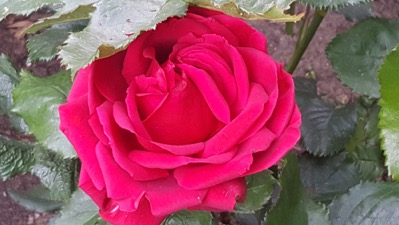

Taking three years from conception to fruition, the project got off to a good start with the offer by Harrogate Borough Council of a set of stone pillars that had been in store since the 1990s. This was originally part of a generous gift to the people of Harrogate in 1911 by William Henry Baxter, a local entrepreneur and benefactor. The inventor of a stone crushing machine performing the ‘knapping process’, Mr Baxter had paid for improvements to Walker Road, renamed Kings Road in the process, in celebration of the reign of King Edward VII. His generosity extended to the construction of a fine entrance off Kings Road into the Rose Garden opposite the junction with Cheltenham Mount.
By 1994 it was felt that Harrogate’s future lay in hosting conferences and exhibitions and the entrance was dismantled to make way for Exhibition Hall M. The gates and some of the railings were sold to a scrap metal dealer in Ripon. If at all possible, it was highly desirable to re-unite the gates and railings with the pillars and enquiries with the dealer revealed the identity of their purchaser. A Council employee had had in mind a project incorporating these and had purchased them. Amazingly, so long after leaving Ripon, they were not only located in a remote field above Pateley Bridge, but it became known that they were available to purchase. The owners, farmers, were contacted and after some ‘Yorkshire’ discussion a price was agreed. The money was counted out on a straw bale and the gates, five ‘king posts’ and 19 railings were loaded on to a wagon belonging to Kendrew Architectural Metalwork. Kendrews had already been approached by the Friends to restore the cast iron gates as a separate contract for which funding was to be sought from the Ironmongers’ Company, an ancient livery company in the City of London.
The difficult business of fundraising for the rest of the project was undertaken with a will and gradually, thanks to the generosity of individuals and organisations, including North Yorkshire County Council Locality Budgets and Harrogate Borough Council, the bank balance grew to a point where it was felt sufficient to fund the entire project and so the procurement process could start. It had previously been agreed that the project should not start until all the funding had been obtained.
The procurement process was a joint exercise with Harrogate Borough Council and the latter’s method was utilized. Eight companies responded to the invitation to tender and, eventually, a winner, TWS Construction (uk) Ltd of Thirsk, was appointed. This company had recently worked on the Japanese Garden project and Harrogate Borough Council felt there were advantages in dealing with them for this contract.
One of the strengths the project had was the expertise of the Friends’ team leader, who, as a qualified civil engineer, provided detailed drawings and specifications that would otherwise have cost the project dearly. Construction started on 24 April and the finishing touches were applied on 13 August. Care had been taken throughout to capture the heritage aspects of the gate, even down to setting each of the railings in lead.

King Edward VII was known as ‘Edward the Peacemaker’ for his work in fostering good relationships with other European countries and thus provides a fitting link with the adjacent Memorial Rose Garden which commemorates the centenary of the armistice that ended the Great War of 1914-1918. Tommy’s roses represent WWI and Peace roses WWII. The project was concluded with the planting of the roses early November. Harrogate Borough Council has replaced the soil removed from the existing beds to ensure successful growth and has undertaken the design work for the new beds. Friends of Valley Gardens have financed the roses with donations received and the planting was a joint exercise handled by the Friends, Harrogate Borough Council and local community volunteers.
The opening ceremony on Monday 26 November was carried out by County Councillor Robert Windass, Chairman of North Yorkshire County Council and Councillor Bernard Bateman MBE Mayor of Harrogate. Revd Fr. Donald Cumming, Chaplain Army Foundation College conducted the Service of Dedication. The Mayoress of Harrogate, Linda Bateman, Her Majesty’s Deputy Lord Lieutenant, Brian Hunt and Junior Soldiers from the Army Foundation College were also in attendance.
After the ceremonies there was a reception at the Mercer Art Gallery where FOVG President Martin Fish thanked Chairman Jane Blayney for all her hard work over the years.

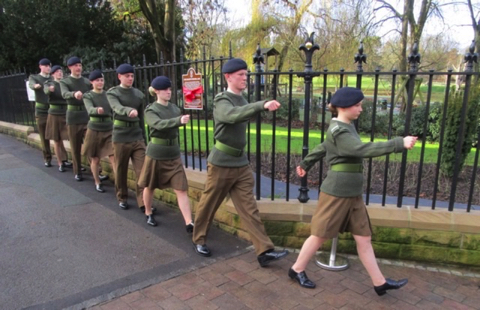
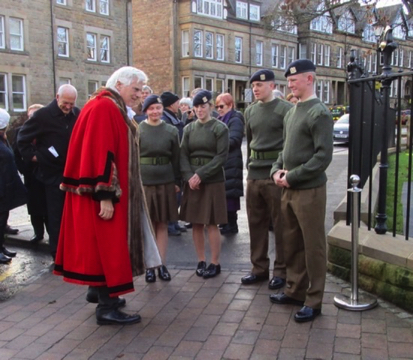
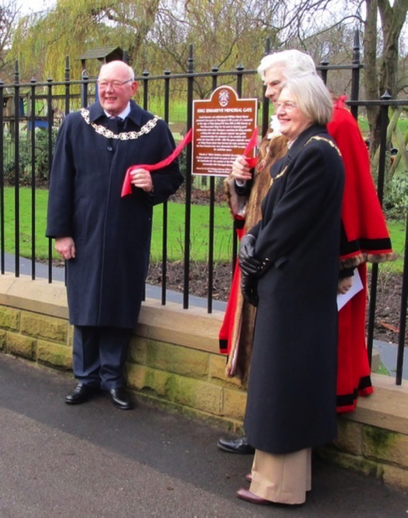
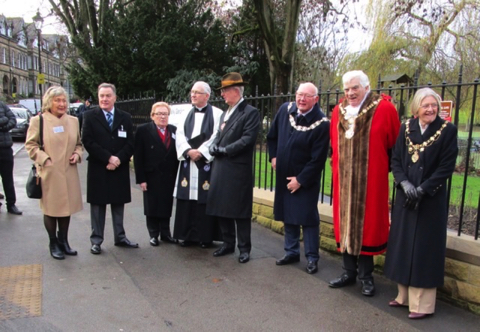

Opened on 26th Nov 2018 (You can download a copy of the Harrogate Advertiser article of 29th Nov regarding the Opening Ceremony by clicking here.)
Project led by David Mason. This project is now complete.
Many years ago, one of the pillars at this entrance was lost because of an accident. This project identified a suitable entrance design and has replaced the old entrance.
The construction part of the King Edward VII Memorial Gate project undertaken by Friends of Valley Gardens in partnership with Harrogate Borough Council is now complete and visitors are rewarded with the spectacle of low walls in natural stone, topped with carved coping stones embracing the much-used south west entrance to the Valley Gardens, formerly known as the Green Park Entrance. The walls are topped by over 200 railings and incorporate two ornate carved stone pillars supporting elaborate cast iron gates.

Green Park Entrance Prior to the Restoration Project

The Original Gate c.1930s

Restored Gate and Roses


Taking three years from conception to fruition, the project got off to a good start with the offer by Harrogate Borough Council of a set of stone pillars that had been in store since the 1990s. This was originally part of a generous gift to the people of Harrogate in 1911 by William Henry Baxter, a local entrepreneur and benefactor. The inventor of a stone crushing machine performing the ‘knapping process’, Mr Baxter had paid for improvements to Walker Road, renamed Kings Road in the process, in celebration of the reign of King Edward VII. His generosity extended to the construction of a fine entrance off Kings Road into the Rose Garden opposite the junction with Cheltenham Mount.
By 1994 it was felt that Harrogate’s future lay in hosting conferences and exhibitions and the entrance was dismantled to make way for Exhibition Hall M. The gates and some of the railings were sold to a scrap metal dealer in Ripon. If at all possible, it was highly desirable to re-unite the gates and railings with the pillars and enquiries with the dealer revealed the identity of their purchaser. A Council employee had had in mind a project incorporating these and had purchased them. Amazingly, so long after leaving Ripon, they were not only located in a remote field above Pateley Bridge, but it became known that they were available to purchase. The owners, farmers, were contacted and after some ‘Yorkshire’ discussion a price was agreed. The money was counted out on a straw bale and the gates, five ‘king posts’ and 19 railings were loaded on to a wagon belonging to Kendrew Architectural Metalwork. Kendrews had already been approached by the Friends to restore the cast iron gates as a separate contract for which funding was to be sought from the Ironmongers’ Company, an ancient livery company in the City of London.
The difficult business of fundraising for the rest of the project was undertaken with a will and gradually, thanks to the generosity of individuals and organisations, including North Yorkshire County Council Locality Budgets and Harrogate Borough Council, the bank balance grew to a point where it was felt sufficient to fund the entire project and so the procurement process could start. It had previously been agreed that the project should not start until all the funding had been obtained.
The procurement process was a joint exercise with Harrogate Borough Council and the latter’s method was utilized. Eight companies responded to the invitation to tender and, eventually, a winner, TWS Construction (uk) Ltd of Thirsk, was appointed. This company had recently worked on the Japanese Garden project and Harrogate Borough Council felt there were advantages in dealing with them for this contract.
One of the strengths the project had was the expertise of the Friends’ team leader, who, as a qualified civil engineer, provided detailed drawings and specifications that would otherwise have cost the project dearly. Construction started on 24 April and the finishing touches were applied on 13 August. Care had been taken throughout to capture the heritage aspects of the gate, even down to setting each of the railings in lead.

King Edward VII was known as ‘Edward the Peacemaker’ for his work in fostering good relationships with other European countries and thus provides a fitting link with the adjacent Memorial Rose Garden which commemorates the centenary of the armistice that ended the Great War of 1914-1918. Tommy’s roses represent WWI and Peace roses WWII. The project was concluded with the planting of the roses early November. Harrogate Borough Council has replaced the soil removed from the existing beds to ensure successful growth and has undertaken the design work for the new beds. Friends of Valley Gardens have financed the roses with donations received and the planting was a joint exercise handled by the Friends, Harrogate Borough Council and local community volunteers.
The opening ceremony on Monday 26 November was carried out by County Councillor Robert Windass, Chairman of North Yorkshire County Council and Councillor Bernard Bateman MBE Mayor of Harrogate. Revd Fr. Donald Cumming, Chaplain Army Foundation College conducted the Service of Dedication. The Mayoress of Harrogate, Linda Bateman, Her Majesty’s Deputy Lord Lieutenant, Brian Hunt and Junior Soldiers from the Army Foundation College were also in attendance.
After the ceremonies there was a reception at the Mercer Art Gallery where FOVG President Martin Fish thanked Chairman Jane Blayney for all her hard work over the years.






